Lemon Market Summary


Image: Africa Studio/Shutterstock.com
Lemon Industry Overview
The exact origins of the lemon (Citrus limon) are unknown, though its history dates back as far as 200 A.D. when the fruit is believed to have been brought from India to southern Italy. Reports of lemon cultivation appear in both Iraq and Egypt around 700 A.D. as well as in Sicily and China around the same period. Lemons were valued for their medicinal qualities after they were introduced to the Mediterranean region. Lemons arrived in the New World in the mid-1700s where they were initially grown in California. Cultivation spread to Florida by 1839, leading to commercial production in both states by 1870. Early growers in Florida faced difficulties with reduced yields, as lemon trees are very sensitive to frost. Orchards were planted in Arizona sometime in the 1900s, though at a much smaller scale than in California. Annually, domestic producers generally send about two-thirds of their lemons to the fresh market with the remainder sent to processors. California continues to lead U.S. production, though Mexico is the top producer globally, followed by Argentina and the European Union. Other world exporters of lemons include Chile, South Africa, and Australia. Lemons typically garner the highest price per box of all citrus fruits. Most are used as juice, a garnish, or for cooking, but per capital consumption of fresh lemons continues to climb annually. Lemon peels may be candied or used in cooking. Peels are usually around a quarter-inch thick in various shades of yellow, though some may have green, yellow, or white stripes running lengthwise along the fruit. Peels can range from smooth to rough and are pocked with oil glands. Oils from the peel can be used for essences, perfumes, or in furniture polish and bleaches. The highest demand for lemons is in the summer months with the popularity of lemonade and other juice-based drinks.

Types & Varieties of Lemons
As an oval-shaped fruit with a nipple-like bulge at one end, lemons range in size from 2 to over 4.5 inches in length. Shape is influenced by temperatures; fruit produced in the summer and autumn seasons are rounder and winter and spring fruit are more oval. Pulp is pale yellow and acidic with a distinctive sour taste. The fruit is divided into several segments with few or no seeds. Lemons can be separated into two categories: ‘true’ lemons and ‘rough’ lemons. True lemons are the original fruit thought to originate in India. The three main true lemon varieties are Femminello, Verna, and Sicilian. Sicilian varieties, including Eureka and Lisbon are grown in the United States. Eureka lemons were planted in California in 1858. This variety is elliptic to oblong with a yellow peel, high juice content, and high acidity. They grow year-round but the main seasons are late winter, spring, and early summer. Eureka lemons are mainly produced for fresh consumption in California and not well suited for cultivation in Florida. Lisbon lemons were brought from Portugal to the United States, first introduced in California in 1849. The main crop of Lisbon lemons is in February, with a secondary crop in May. The fruit is very similar to the Eureka variety, with the main difference being that Lisbon lemons often grow inside the tree canopy while Eureka lemons grow in clusters not protected by foliage. Rough lemons are less acidic and larger, with a bumpier peel and more seeds. With little pulp and juice, uses for rough lemons are limited. The primary use is as rootstock for other citrus fruit. In Hawaii and other tropical and subtropical areas, rough lemons are often grown as an ornamental fruit tree. A number of hybrid species are sometimes referred to as lemons, including Meyer or Ponderosa lemons. Neither are true lemons—yet Meyer lemons are often used as a substitute, although they are much less acidic and bear some resemblance to yellowish oranges. Meyers are thought to be a hybrid between a lemon and mandarin. The unusual looking Buddha’s hand lemons are gaining popularity with chefs as a zest. In addition to those mentioned above, other lemon varieties include Armstrong, Avon, Bearss, Berna, Genoa, Harvey, Interdonato, Monachello, Nepali Oblong, Nepali Round, Rosenberger, Santa Teresa, and Villafranca.Cultivation of Lemons
Lemon trees grow from 10 to 20 feet in height with sharp thorny branches. The leaves are large, oblong, and light green. Flowers are purple-white and single or in bunches of two or more, though few pollinated buds will produce fruit. Fertility varies between blooms and seasons. Cross pollination is not required for lemons to set. Trees usually achieve full fruit production by their eighth year and reach their full fruit bearing capacity around 40 years. Lemon trees are less sensitive to cold than lime trees, but since they both grow continuously, they are more susceptible to cold damage and less capable of recovery than orange trees. Lemon trees have a limited climatic range. The best fruit is produced in coastal areas with cool summers, but cold snaps with temperatures below 29°F will kill flowers and new fruit. Just one degree lower can severely damage mature fruit, while the 24 to 22°F range will defoliate trees. Colder temps will damage wood. Lemon trees thrive in temperatures between 79 and 82°F. Fruit grown in more tropical temperatures tend to be larger, juicier, and more acidic. Peels tend to be coarser and with more dullness in coloring than lemons grown in drier conditions. The downside to hot and humid production regions are more issues with plant diseases and damage. Depending on the cultivar and temperatures, the time between flowering and harvest ranges from 4 to 12 months. Many different types of soil are acceptable, including sand or silty clay loam, but pH levels should be between 5.5 and 6.5. Trees grow best with good drainage and tend to be less productive in heavy clay soils. While able to tolerate drought conditions, they are unable to withstand too much moisture or waterlogged soil. Irrigation may be necessary during extended dry periods, but must be carefully monitored. Fertilizer is applied as needed. Rough lemons can be grown from seed, though Meyer lemons are generally grown via root cuttings for transplant. Trees should be well spaced and protected from the wind, which will scar both fruit and trees. Planting distances depend on soil type, but overcrowding may lead to an increased incidence of pests, disease, lower yields, and a greater need for pruning, as trees grow best in full sunlight. Trees may begin producing fruit by their third year with yields from 30 to 40 pounds per tree. Mature trees can produce from 100 to 200 pounds per year. Lemons are harvested at different stages depending on purpose and marketing. Harvest seasons depends on cultivar and climate, though availability is all year. Tree yields are usually measured in field bins per acre with cartons for shipping. California and Arizona producers pick lemons after they’ve attained 25% juice content. Some, such as Italian lemons, are picked early and cured. Others are harvested at maturity. Mature fruit generally has a light green peel. Oil spotting can occur when lemon peels become bruised. To avoid bruising, lemons should be handled with care during harvest and not picked when wet.
Pests & Diseases Affecting Lemons
Two major pests of concern are the Caribbean fruit fly and Asian citrus psyllid. The tiny Asian citrus psyllid feeds on the young stems and leaves of trees and are difficult to detect and prevent. The psyllid is known for transmitting citrus greening, the bacterial disease that has wreaked havoc with orange production throughout Florida, and has been found in a few orchards in California. Growers should also look out for purple scale and California red scale, as well as brown citrus aphids, citrus leafminers, rust and red mites, and nematodes in soil. Common diseases include citrus canker, phytophthora molds, rust, scab, anthracnose, damping-off, greasy spot, leaf spot, felt fungus, stem-end rot, alternaria rot, various types of root rot and wood rot, as well as crinkly leaf and exocortis viruses.Storage & Packaging of Lemons
Fruit is packed into bins in the field and transported to packhouses for cleaning, grading, sizing, and final packing. Fruit is graded by color intensity and uniformity, size, shape, smoothness of the skin, firmness, and absence of decay, defects, damage, stains, and discoloration. After sorting, lemons are washed and coated with a fungicide and thin wax layer before curing in storage and later shipping. Some growers cure loose fruit before grading then have another round of curing. Early-picked lemons require about three weeks of curing to attain the best color but green lemons may be kept for four months or longer. More mature lemons may need less than a week to cure. Degreening can be expedited by exposure to ethylene, but overexposure can promote decay. Packing lemons in thick, high-density polyethylene may minimize decay and allow storage for up to six months. Lemons can generally be kept for up to six months between 54 and 57°F with 90 to 95% relative humidity. Lemons exported from Florida to Hawaii and Arizona are fumigated with methyl bromide to prevent Caribbean fruit fly infestations. References: PennState University, Purdue University, Texas A&M University, University of California Cooperative Extension, University of California, Davis, University of Florida/IFAS Extension, USDA.Grades & Good Arrival of Lemons
Generally speaking, the percentage of defects shown on a timely government inspection certificate should not exceed the percentage of allowable defects, provided: (1) transportation conditions were normal; (2) the USDA or CFIA inspection was timely; and (3) the entire lot was inspected.| U.S. Grade Standards | Days Since Shipment | % of Defects Allowed | Optimum Transit Temp. (°F) |
| 12-7-3 | 5 4 3 2 1 | 15-8-5 15-8-5 14-8-4 13-7-4 12-7-3 | 45-55° |
Inspector's Insights for Lemons
- Any amount of mold from a decayed lemon affecting a sound lemon is scored as a defect
- Lemons are prone to internal defect and decline, usually found starting at the stylar end; any amount is scored as a serious damage defect
- Peteca is a deep, sharply defined pitting or sinking of the rind surface and scored as a defect when more than two spots or aggregating more than a quarter-inch in diameter.
Lemon Retail Pricing: Conventional & Organic Per Pound



